Electron Engine ™
Printed Circuit Boards by Emissionlabs ®
EE20 Gold Plated Multi Purpose Board. Version 2.9
 Moving Coil , Applications (You are here)
Moving Coil , Applications (You are here) - Moving Coil, Tuning
Possible Moving Coil transformers:
LL1636, LL1678, LL9206, LL9226, LL9226XL
The MC cartridge is connected to L+ and L-, with the options to connect the cable shield, ground, etc. The best sounding step up ratio can be found, just by trying out, and adjustable damping of the tone cartridge is possible as well.
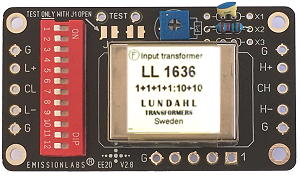 All Lundahl options, and some additional step up ratios have become possible, all of which can be tried out conveniently, just by setting the Switches. For hard core audiophiles, the switches can be replaced by wire pieces as well. Yet the contact resistance of the switch is only theoretical, because we switch the transformer windings, which represent a great length of very thin wire, with 1000x more resistance than the switch.
All Lundahl options, and some additional step up ratios have become possible, all of which can be tried out conveniently, just by setting the Switches. For hard core audiophiles, the switches can be replaced by wire pieces as well. Yet the contact resistance of the switch is only theoretical, because we switch the transformer windings, which represent a great length of very thin wire, with 1000x more resistance than the switch.
Option1 vs. Option2
For purchasing just order the transformer with Option1 or Option2. Order numbers for this are in the price list, with each transformer. Option2 uses the same PCB as Option 1, but you receive additional the external switch board EE22, which can be attached to the EE20 board.
The external switch board can also be bought later, to upgrade from Option1 to Option2.
Gain |
Set Switches |
||||
#1 |
Designation |
Ordered with Option1 |
With Option2 Low / High is the external switch position |
||
#2 |
4x |
2.5x |
New! Possible with EE20 board |
1, 3, 7, 9, 11 | 7, 9, 11, Low (High = twice the gain) |
#3 |
5.3x |
3.3x |
New! Possible with EE20 board
|
1, 3, 5, 7, 8, 11 | 5, 7, 8, 11, Low (High = twice the gain) |
#4 |
8x |
5x |
Lundahl Alt A |
2, 7, 9, 11 | 7, 9, 11, High (Low = half the gain) |
#5 |
8x |
5x |
Lundahl Alt B |
1, 3, 5, 7, 8, 10, 12 | 5, 7, 8, 10, 12, Low (High = twice the gain) |
#6 |
11x |
6.7x |
New! Possible with EE20 board
|
2, 5, 7, 8, 11 | 5, 7, 8, 11, High (Low = half the gain) |
#7 |
16x |
10x |
Lundahl Alt C Most recommended |
2, 5, 7, 8, 10, 12 | 5, 7, 8, 10, 12, High (Low = half the gain) |
#8 |
16x |
10x |
Lundahl Alt D Only for very low impedance cartridges. |
1, 3, 4, 5, 6, 8, 10, 12 |
4, 5, 6, 8, 10, 12, Low (High = twice the gain) |
#9 |
32x |
20x |
Lundahl Alt E |
2, 4, 5, 6, 8, 10, 12 | 4, 5, 6, 8, 10, 12, High (Low = half the gain) |
LL1636 has an internal shield between each layer of inter sectioning, which increases the noise suppression a lot. The price for this, the room this takes internally, and so the wire diameter had to be slightly thinner, compared to LL9206. This increases the copper resistance of the LL1636 secondary from 395Ohm to 415 Ohms, however when loaded with 47k, like the standard for RIAA, this is insignificant.
LL9226 has lower copper resistance, which is better for low impedance inputs, but it fails the internal shielding of LL1636. The failing shield also increases the frequency range from 90kHz to 100kHz. Personally I prefer LL1636 because hum is something I can hear, but the difference between 90kHz and 100kHz I can not hear. Also, LL9226 has a very minor increase in output signal with very low impedance MC systems, but the trade off between this, and better shielding, goes into the direction of the LL1636. (This Just my personal opinion).
LL1678 is the gain master, maximum 32x is really very much and there is no alternative if this gain is needed.
Connection Schemes
Circuit #1
Most recommended for Record Players.
Works with all transformers, also LL1636.
This connection scheme is the most used. Basically everything is grounded to the PCB Ground plane, which is double sided.
This uses a normal, grounded RCA connector, all woring is classical and normal, and little to say about it, with no complications or difficutlies. 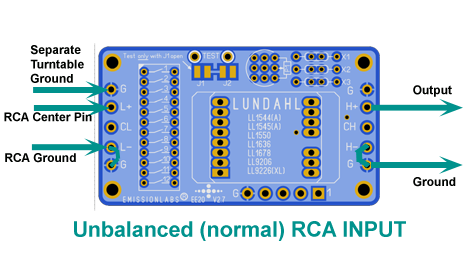
Circuit #2
Works best with LL1636
LL1636 is the only transformer of this family with a real static shield inside, which makes it specially suited for floating input connection, as we are doing here. This MAY become a problem solver for hums problems for which the reason can not really be found. You can also try his circuit with any other transformer, though it targets mainly for LL1636. The only difference between with circuit #1 or #2 is:
- Circuit #2 does not use the small ground link from L- to G (as in circuit#1)
- A floating ground RCA connector must be used.
- Circuit #1 can be used with all transformers, also LL1636
- Circuit #2 works best with LL1636, but MAY work with any other.
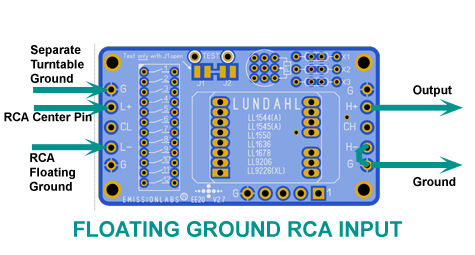
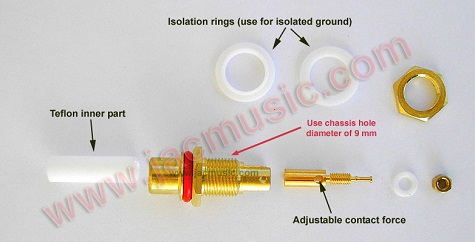
Yamamoto Floating Ground RCA (Cinch) Connector
Ways to use this scheme:
- Create a Moving Coil RCA input with a MM amplifier, while the board EE20 is build inside the amplifier. This requires floating ground connectors.
- Not recommended, but you can try with standard (grounded) connectors, if these are already mounted and you have no option to change something. In that case, make a link from L- to G, and only the RCA center pin is connected to L+. Yet if it is humming, you need to install a floating ground RCA chassis connector. (like the picture above).
- Create a separate box, with RCA input and RCA Output. With a metal case, connect it to where it says Ground on the schematic. The input is a floating type connector, the output is a grounded type.
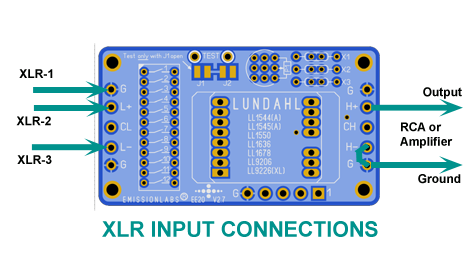
Ways to use this scheme
- Create a Moving Coil XLR input to an MM amplifier, while the board EE20 is build inside the amplifier
- Build a separate box, with XLR input and grounded RCA Cinch connectors at the output.
- In both cases, it has to be tried out, what is best for the Input XLR-1 ground connection, because this connects the record player chassis to the RIAA amplifier chassis. Try this out, and take what is best. When it makes no difference, connect Input XLR-1 to 'G'. To be universal, use a miniature external switch for this.
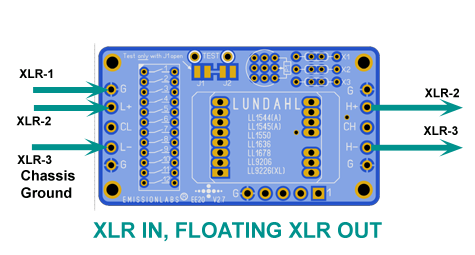
This is for an external box. Since the output is floating, the board ground should be connected to the record player chassis, via XLR-1.
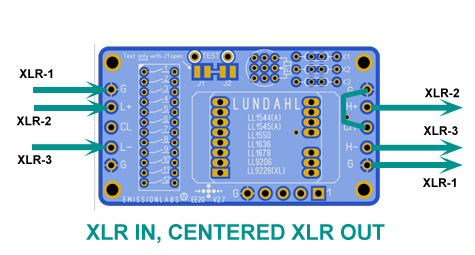
This is for an external box. XLR is not floating, but is centered to ground, by connecting it's center (CH connection) to ground.
it has to be tried out, what is best for the Input XLR-1 ground connection, because this connects the record player chassis to the RIAA amplifier chassis. Try this out, and take what is best. When it makes no difference, connect Input XLR-1 to 'G'. To be universal, use a miniature external switch for this.
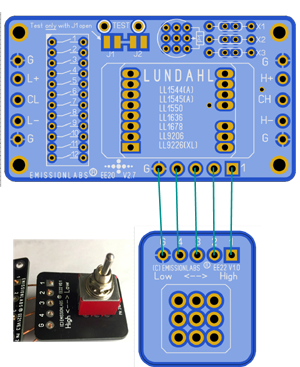 All Schemes are possible, using the EE20 Board stand alone, or with the EE22 Board.
All Schemes are possible, using the EE20 Board stand alone, or with the EE22 Board.